The Scintillators Market is estimated to be valued at USD 597.1 million in 2025 and is projected to reach USD 927.2 million by 2035, registering a compound annual growth rate (CAGR) of 4.5% over the forecast period.
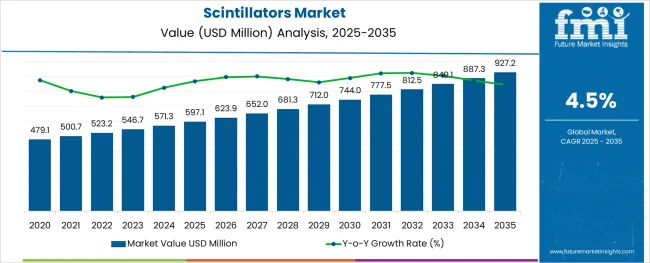
The scintillators market is undergoing strategic transformation, driven by increased utilization in medical imaging, nuclear safety, homeland security, and high-energy physics. The ability of scintillators to convert high-energy radiation into visible light has made them essential in systems requiring precise radiation detection and visualization. Growing investments in nuclear power infrastructure and medical diagnostics are prompting demand for advanced scintillation materials with higher resolution, faster response times, and temperature stability.
Emerging innovations in composite scintillators and nanomaterial-based designs are enhancing detection sensitivity while improving cost efficiency. Regulatory emphasis on radiation safety and environmental monitoring is pushing governments and enterprises to adopt portable and fixed detector systems incorporating scintillation technology.
Future opportunities are likely to emerge from advancements in hybrid photodetectors, lightweight scintillating composites, and real-time digital imaging solutions. As industries increasingly prioritize safety, traceability, and precision diagnostics, scintillators are expected to play a central role in driving functional advancements and operational reliability.
The market is segmented by Product Type and Application and region. By Product Type, the market is divided into Organic Crystals, Organic Liquids, and Plastic Scintillators. In terms of Application, the market is classified into Radiation Detection, Medical Imaging, and Others. Regionally, the market is classified into North America, Latin America, Western Europe, Eastern Europe, Balkan & Baltic Countries, Russia & Belarus, Central Asia, East Asia, South Asia & Pacific, and the Middle East & Africa.
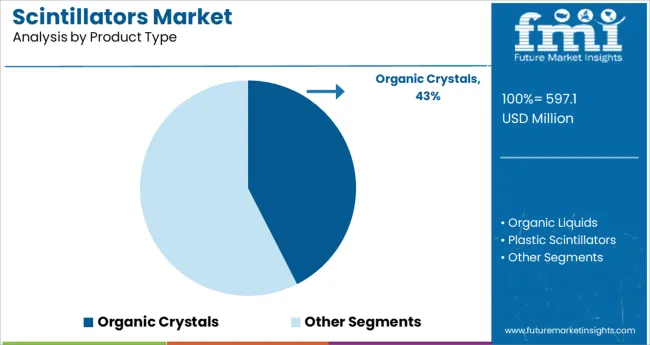
Organic crystals are projected to lead the product type category with a 42.5% revenue share in 2025. This dominance is attributed to their fast decay time, ease of fabrication, and cost-effective production compared to inorganic counterparts.
Organic scintillators have been widely adopted in applications where timing resolution and rapid signal processing are critical, especially in high-energy physics and medical imaging. Their relatively low density is offset by superior timing characteristics and ease of customization for different detector geometries.
As advancements in composite organic materials continue to enhance light output and radiation tolerance, the segment is expected to maintain its position as the preferred choice for real-time radiation monitoring. The ability of organic crystals to support portable and compact detector designs has further fueled their deployment in field-based and handheld systems, reinforcing their leadership across both institutional and commercial end users.
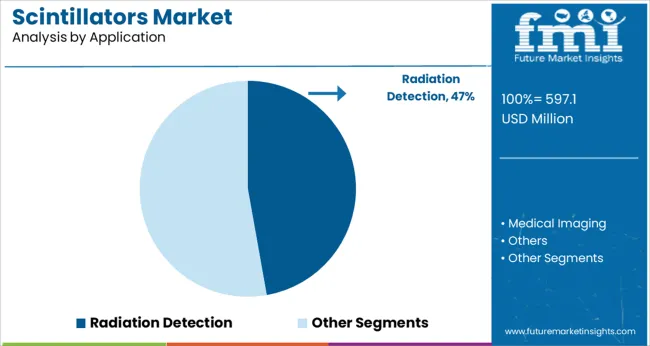
Radiation detection is anticipated to account for 47.2% of total revenue in 2025, making it the leading application in the scintillators market. This leadership has been driven by rising global demand for radiation monitoring in nuclear power plants, homeland security, industrial safety, and medical diagnostics.
The versatility of scintillators in detecting alpha, beta, gamma, and neutron radiation has positioned them as critical components across fixed and portable detection systems. Governments and regulatory bodies are mandating enhanced safety protocols in environments exposed to ionizing radiation, encouraging the installation of advanced radiation detectors.
Scintillators are increasingly being used in digital radiation monitoring equipment due to their ability to deliver real-time, high-resolution results with reliable signal stability. As infrastructure for nuclear medicine, energy, and public security expands, the need for precise and fast radiation detection is expected to rise, thereby reinforcing this application segment’s dominant share and long-term growth trajectory.
Rising demand for novel radiological medical applications and increased use of radiation monitoring in homeland security are some of the factors driving the scintillator market. As new applications emerge and portable detectors and small radiators become more popular, the demand for scintillators with advanced tech and small sizes is likely to grow during the forecast period.
Many companies, particularly those producing low-cost yet high-resolution radiation detection equipment, rely on scintillators for their large production capacity. As a result, it is difficult for small businesses to maintain their position in industries that are price sensitive. In addition, the presence of a large number of well-known manufacturers in the surrounding regions is likely to hamper the entry of new players in the scintillators market.
Growing demand from the medical equipment and gadgets business is predicted to boost the scintillators market size during the forecast period. Radiation detection materials have been the subject of continual research and development, which is projected to have a significant impact on demand over the projection period.
Radiological terror strikes are becoming more and more likely, and this is expected to result in an increase in demand for domestic security services. As a response, governments in the United States and Europe have increased their spending on security and military business. Over the next few years, this is expected to be a major driver of growth for the scintillators market.
As per the scintillators market study, demand for scintillators is high coming in from medical professionals to identify and assess the illnesses of the heart and brain. Since these illnesses are becoming more common, there is a growing need for scintillators around the world. There is also growing pressure on hospitals and healthcare organizations to use high-tech scintillation and radiation detectors because of strict rules being implemented by governments throughout the world on the usage of medical devices.
Scintillators are used by security and defense agencies around the world to strengthen homeland security and prevent human loss. While solid organic scintillators are being developed for use in detecting radioactive substances and in preventing radiological hazards, the Department of Homeland Security (DHS) has been encouraging the development of these materials under their Small Business Innovative research programs.
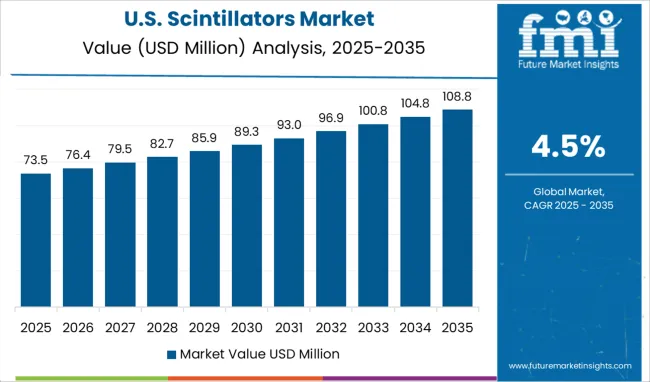
The demand for scintillators is dominated by North America, both in terms of consumption and production output. The scintillators market in North America is expected to hold a market share of 27.6% by the end of 2025. This can be attributed to the recent legislation passed by the United States government in an effort to modernize its approach to risk mitigation.
As the number of cancer patients who require the adoption of scintillators for treatment continues to rise, the American Cancer Society has made it a priority to raise awareness about the benefits of using these devices.
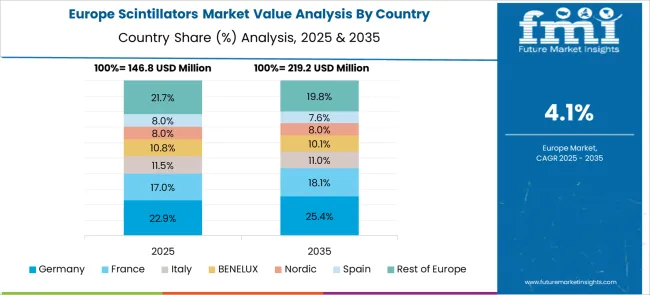
When it came to the implementations that had an effect on the economy, Europe is expected to grow at a significant pace, following North America, with a scintillators market share of 23.5% by the end of 2025. This was especially true in the medical and healthcare industries. The rapid expansion is mostly due to the vast amount of research and development activities, as well as the increased financial contributions made by governments.
Owing to the rapid growth of the healthcare industry, European countries such as France, Germany, and Italy are currently in the top position in the scintillators market. It is projected that the demand for scintillators would expand at a significant rate due to the real size of the market as well as the rise in the proportion of the pharmaceutical industry that uses scintillators for a variety of applications.
How is the Start-up Ecosystem in the Scintillators Market?
The growth of the scintillators market is being driven in large part by recent technological advancements. Market participants are placing a greater emphasis on the development of products that are easier to get. Because many firms are investing heavily in research and development, the scintillators industry is expanding at a rapid rate.
Saint Gobain and Toshiba are two of the few companies that are present at every stage of the value chain for the materials used in inorganic scintillators. These businesses are concentrating on expanding their customer bases while simultaneously looking for ways to improve their profit margins through the process of integration.
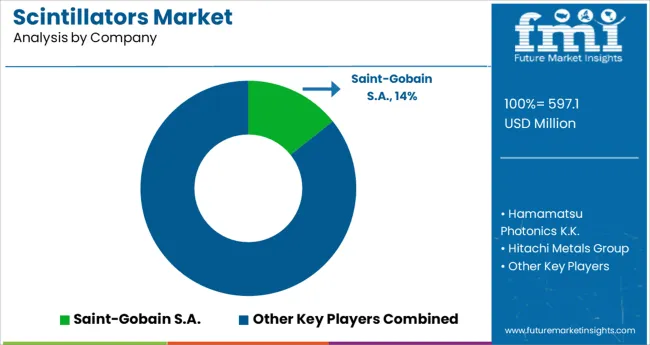
There are a variety of global and regional players competing in the global demand for scintillators, which is characterized by a relatively high degree of fragmentation.
Manufacturers operating in the scintillators market are intensifying their focus on the integration of scintillators with nanophotonics, which increases the ability of the detectors to extract light. In addition, some of the significant developments that have been made in the scintillators market by players include quick decay times and the ability to produce a lot of light. The product's mobility and portability have increased as a direct result of technological improvements, such as the advent of scintillators that can be operated by hand.
Recent Developments
| Report Attribute | Details |
|---|---|
| Growth rate | CAGR of 4.5% from 2025 to 2035 |
| The base year for estimation | 2024 |
| Historical data | 2020 to 2024 |
| Forecast period | 2025 to 2035 |
| Quantitative units | Revenue in USD billion and CAGR from 2025 to 2035 |
| Report Coverage | Revenue forecast, volume forecast, company ranking, competitive landscape, growth factors, and trends, Pricing Analysis, |
| Segments Covered | Product Type, Application, Region |
| Regional scope | North America; Western Europe, Eastern Europe, Middle East, Africa, ASEAN, South Asia, Rest of Asia, Australia, and New Zealand |
| Country scope | United States of America; Canada; Mexico; Germany; United Kingdom; France; Italy; Spain; Russia; Belgium; Poland; Czech Republic; China; India; Japan; Australia; Brazil; Argentina; Colombia; Saudi Arabia; UAE; Iran; South Africa |
| Key companies profiled | Dynasil Corporation of America; Hamamatsu Photonics K.K.; Hitachi Metals Group; Detec; Rexon Components, Inc.; Saint-Gobain S.A.; Scintacor; Toshiba Materials Co., Ltd.; EPIC Crystal Co., Ltd.; Amcrys; Shanghai Siccas High Technology Corporation; Alpha Spectra, Inc.; Nihon Kessho Kogaku Co. |
| Customization scope | Free report customization (equivalent to up to 8 analysts' working days) with purchase. Addition or alteration to country, regional & segment scope. |
| Pricing and purchase options | Avail customized purchase options to meet your exact research needs. |
The global scintillators market is estimated to be valued at USD 597.1 million in 2025.
It is projected to reach USD 927.2 million by 2035.
The market is expected to grow at a 4.5% CAGR between 2025 and 2035.
The key product types are organic crystals, organic liquids and plastic scintillators.
radiation detection segment is expected to dominate with a 47.2% industry share in 2025.






Full Research Suite comprises of:
Market outlook & trends analysis
Interviews & case studies
Strategic recommendations
Vendor profiles & capabilities analysis
5-year forecasts
8 regions and 60+ country-level data splits
Market segment data splits
12 months of continuous data updates
DELIVERED AS:
PDF EXCEL ONLINE
Inorganic Scintillators Market Size and Share Forecast Outlook 2025 to 2035
Industry Share Analysis for Inorganic Scintillators Companies

Thank you!
You will receive an email from our Business Development Manager. Please be sure to check your SPAM/JUNK folder too.
Chat With
MaRIA